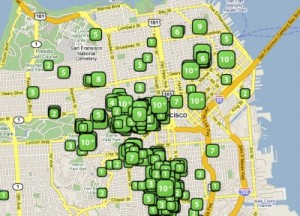Today the KW Record ran an article entitled “Blanket Wi-Fi plans unplugged in Waterloo Region and Guelph, but growing in Stratford”. I thought I’d throw in my two cents since this issue is very related to some of my research. Overall to me, the biggest factor that contributed to the failure of blanket wireless access in the Region of Waterloo was the cost of the service for users. From what I remember, it was on part with many high speed Internet plans. Why would someone pay the same price to have potentially slower, less secure service than competing wired services?
The Atria plan used large WiFi cells, with very expensive antennas (see the apartment building near University Plaza, which I believe was one of them).
Many other cities (much larger ones) have been very successful in providing blanket WiFi, using a completing different coverage model and cost model. The best example is San Francisco where a company named Meraki provides free wifi for over 100,000 people using their Mesh Router devices. These devices cost between $399 and $1500 each, which is still expensive, but likely much cheaper than anything used by Atria. These devices likely have much lower range and handle dense areas compared with the atria cells which seem to be designed for large areas, and require many people to subscribe to pay for their costs. The argument in the article that WiFi coverage in metropolitan areas is difficult seems like a terrible attitude to have for an area that has a reputation as a high tech leader. San Francisco likely has much greater challenges in this regard compared to our tiny city.

Instead of using these expensive devices, much cheaper devices such as linksys wrt routers could be used. These routers support linux, and because of this much customization is possible such as mesh networking. While these devices are less reliable than the previous more expensive solutions, it may be a good way to at least get the network started cheaply. Additionally, areas which are not used by as many people could be covered with cheaper routers, while areas with more dense traffic may be covered by expensive ones.
The argument in the article that WiFi networks are unnecessary because of cellular networks is ludicrous! If that is the case, why are every smartphone and other device including WiFi radios in them? It’s because data on cellular networks is way to expensive. Any place where a device can get free or low cost WiFi should be used instead of the cellular network. One large problem with this at the moment, however is that it is not seamless to go from a cellular network to a wifi network. For example, it is often not possible to carry on a phone call while switching networks, or continue downloading or steaming without interruption. This will change with much of the [research in heterogeneous networks](https://web.archive.org/web/20120429183902/http://www.uoguelph.ca/~jernst/research.shtml).
One potential model that hasn’t been explored much is community wireless networks. In this case, devices could be provided to anyone willing to provide access to their own home network for the community. The incentive could be either donations from users, or a very small fee (2 – 5 dollars per month) which is distributed to providers. Additionally, anyone who provides a part of the network is able to get on free to other parts of the network. Of course, there’s nothing to stop the larger companies like Rogers and Bell from creating the same type of value added service. Since so many people already have wireless in their home using Rogers and Bell, they could create some type of login where you take your bandwidth quota with you and have access to anyone else’s network who is also participating. This way, you are not using their bandwidth cap (only their “speed” – which may introduce a whole other range of problems :P )